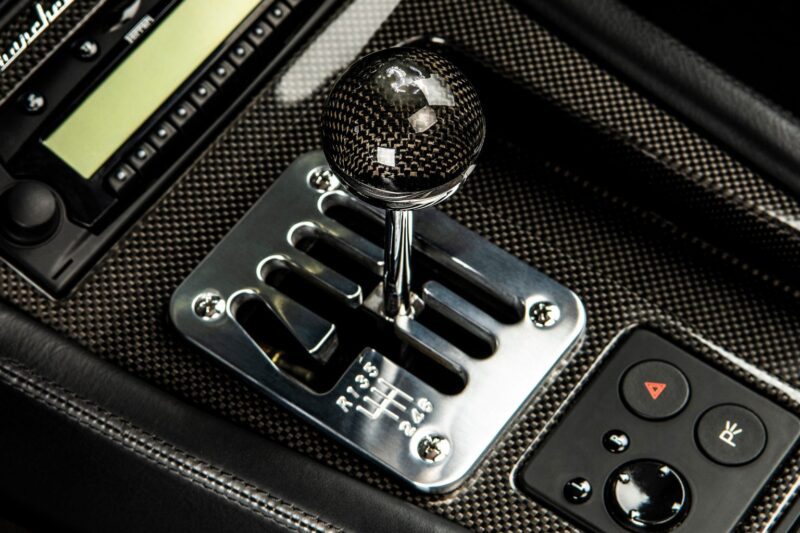Presented by Speedart Motorsports.
At $1 billion in vinyl record sales, 2021 was the biggest year for vinyl since 1986, according to the Recording Industry Association of America. At just 11% of all revenues, physical sales are still exploding — with vinyl revenue growing 61% year over year. Vinyl record sales have grown rapidly for more than a decade – surpassing both digital and CD album sales. And while you might think it’s nostalgic Boomers or Gen Xers behind the renaissance of records, in fact surveys show it’s millennial consumers driving the rising trend in vinyl sales.
Now you may ask me what vinyl has to do with three pedals but I am sure you are getting the hint of my intention to correlate music trends with stick-shift cars.
Unlike vinyl record manufacturers upping the production to meet the explosive demand, sports car manufacturers are steering clear from the traditional drivetrains. So why a manual 599 GTB is selling for almost three times the price of an equivalent F1 or why a GT3 Touring commanding such a hefty premium over its PDK counterpart, which happens to be faster and more technologically advanced? Should I also mention that these kinds of transmissions were paid options when new?
According to the U.S. Environmental Protection Agency, 35% of cars for sale in the U.S. had manual transmissions in 1980, but by 2022 it is down to less than 1%.
With only 18% of American drivers who can even handle a stick, it is obvious that car manufacturers have to adapt to the market demand but here we are not debating as to why Volvo does not offer their premium family sedans with a manual transmission but considering that the last prancing horse with its iconic gated shifter rolled off the Modenese factory almost a decade ago, is definitely anti-climatic. For the record, to the Ferrari cognoscenti who are reading this, it was not the F430 or the 599GTB or even the 612 Scaglietti but interestingly enough the last manual Ferrari was the docile V8 California. Lamborghini is another equal opportunity offender among others, with the 2014 Gallardo being the swan song of their magnificent Graziano 6-speed gearbox.
So why such an allure and demand for this archaic technology? Is it nostalgia, driver engagement, cool factor, rarity, etc.? Maybe it’s all of the above and in no particular order. If someone argues that the main factor of preference is control then I beg to differ, since a double-clutch transmission or even an automated sequential gearbox that is fitted to most high-performance automobiles today, provides better control when used adequately, with gear changes into milliseconds and simply faster for that matter.
Another interesting fact is that, unlike naturally aspirated engines that will no longer be able to meet the stricter and stricter environmental conformities, cars with manual transmissions have lower emissions. Now, let’s be honest, no advocate of the internal combustion powered automobile or seasoned motoring enthusiast would be considered a champion of the environment cause but don’t believe car makers when trying to justify that everything they do is for the betterment of our planet. Car companies do no longer reflect the visions of charismatic individuals or automotive pioneers but rather controlled by accountants, shareholders and boards of directors motivated by bottom line performance.
What is the future of the manual gearbox? Unfortunately, since we are moving rapidly towards full electrification there is not enough time for manufacturers to reevaluate their offerings and capture their stick shift audiences. Some car makers like Porsche, BMW, VW, GM, Ford, and a few others from Japan sympathize with the trend and still retain the manual gearbox in their portfolios albeit in select models and minimal quantities.
On the hypercar sphere, we may still find some boutique manufacturers like Gordon Murray Automotive with his honest attempt to build a pure manual thoroughbred the T.50, and Koenigsegg of Sweden to offer a commemorative variant of the CC8. The transmission of the CC850 is really a unique approach called the Engage Shift System (ESS), this multi-ratio transmission is based on the Jesko’s multi-clutch Light Speed Transmission and allows for both manual and automatic shifting. In manual mode, the ESS has six speeds and a clutch pedal; But the ESS can also be put into automatic mode, where it has nine speeds and shifts on its own. Are these examples the last of the breed? Quite possible.
In the collector’s community, the values of the majority of sports cars from the 80s and before, with the exception of a few do not suffer from such transmission diversification but the disparity of values on contemporary manual supercars (and not so super) versus the automated ones will grow even larger as the years pass. I am not fond of future market predictions but in the ‘youngtimers’ domain investment-wise, an atmospheric V12 with a stick shift especially will be definitely seating at the top of the food chain.
So, just like removing an LP from the sleeve with its dazzling artwork, place on the top of a beautiful belt-driven turntable, set the stylus, and wait as that warm crackle prefaces that rare experience, there is a certain romance and connection associated with the ritual of going through the gears of a sporting machine by engaging the clutch pedal and feeling the precise clicking action of the gated shifter. And while you are at it, do not mind that you are down-shifting a synchromesh gearbox… go ahead and blip the throttle. Very soon you might be able to claim that you possess the lost art of driving!
